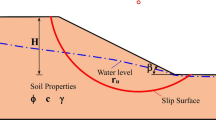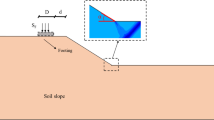Abstract
Stability of the soil slopes is one of the most challenging issues in civil engineering projects. Due to the complexity and non-linearity of this threat, utilizing simple predictive models does not satisfy the required accuracy in analysing the stability of the slopes. Hence, the main objective of this study is to introduce a novel metaheuristic optimization namely Harris hawks’ optimization (HHO) for enhancing the accuracy of the conventional multilayer perceptron technique in predicting the factor of safety in the presence of rigid foundations. In this way, four slope stability conditioning factors, namely slope angle, the position of the rigid foundation, the strength of the soil, and applied surcharge are considered. Remarkably, the main contribution of this algorithm to the problem of slope stability lies in adjusting the computational weights of these conditioning factors. The results showed that using the HHO increases the prediction accuracy of the ANN for analysing slopes with unseen conditions. In this regard, it led to reducing the root mean square error and mean absolute error criteria by 20.47% and 26.97%, respectively. Moreover, the correlation between the actual values of the safety factor and the outputs of the HHO–ANN (R2 = 0.9253) was more significant than the ANN (R2 = 0.8220). Finally, an HHO-based predictive formula is also presented to be used for similar applications.







Similar content being viewed by others
References
Pourghasemi HR, Pradhan B, Gokceoglu C (2012) Application of fuzzy logic and analytical hierarchy process (AHP) to landslide susceptibility mapping at Haraz watershed, Iran. Nat Hazards 63:965–996
Latifi N, Rashid ASA, Siddiqua S, Majid MZA (2016) Strength measurement and textural characteristics of tropical residual soil stabilised with liquid polymer. Measurement 91:46–54
Moayedi H, Huat BB, Kazemian S, Asadi A (2010) Optimization of tension absorption of geosynthetics through reinforced slope. Electron J Geotech Eng B 15:1–12
Marto A, Latifi N, Janbaz M, Kholghifard M, Khari M, Alimohammadi P, Banadaki AD (2012) Foundation size effect on modulus of subgrade reaction on sandy soils. Electron J Geotech Eng 17:2523–2530
Moayedi H, Huat BK, Kazemian S, Asadi A (2010) Optimization of shear behavior of reinforcement through the reinforced slope. Electron J Geotech Eng 15:93–104
Raftari M, Kassim KA, Rashid ASA, Moayedi H (2013) Settlement of shallow foundations near reinforced slopes. Electron J Geotech Eng 18:797–808
Nazir R, Ghareh S, Mosallanezhad M, Moayedi H (2016) The influence of rainfall intensity on soil loss mass from cellular confined slopes. Measurement 81:13–25
Javankhoshdel S, Bathurst RJ (2014) Simplified probabilistic slope stability design charts for cohesive and cohesive-frictional (c − ϕ) soils. Can Geotech J 51:1033–1045
Duncan JM (1996) State of the art: limit equilibrium and finite-element analysis of slopes. J Geotech Eng 122:577–596
Kang F, Xu B, Li J, Zhao S (2017) Slope stability evaluation using Gaussian processes with various covariance functions. Appl Soft Comput 60:387–396
Trigila A, Iadanza C, Esposito C, Scarascia-Mugnozza G (2015) Comparison of logistic regression and random forests techniques for shallow landslide susceptibility assessment in Giampilieri (NE Sicily, Italy). Geomorphology 249:119–136
Hervás-Martínez C, Gutiérrez PA, Peñá-Barragán JM, Jurado-Expósito M, López-Granados F (2010) A logistic radial basis function regression method for discrimination of cover crops in olive orchards. Expert Syst Appl 37:8432–8444
Basarir H, Kumral M, Karpuz C, Tutluoglu L (2010) Geostatistical modeling of spatial variability of SPT data for a borax stockpile site. Eng Geol 114:154–163
Secci R, Foddis ML, Mazzella A, Montisci A, Uras G (2015) Artificial neural networks and kriging method for slope geomechanical characterization, engineering, geology for society and territory-volume 2. Springer, Switzerland , pp 1357–1361
Zhang Y, Dai M, Ju Z (2015) Preliminary discussion regarding SVM kernel function selection in the twofold rock slope prediction model. J Comput Civil Eng 30:04015031
Moayedi H, Nazir R, Mosallanezhad M, Noor RBM, Khalilpour M (2018) Lateral deflection of piles in a multilayer soil medium. Case study: the terengganu seaside platform. Measurement 123:185–192
Mosallanezhad M, Moayedi H (2017) Developing hybrid artificial neural network model for predicting uplift resistance of screw piles. Arab J Geosci 10:479
Gao W, Karbasi M, Hasanipanah M, Zhang X, Guo J (2018) Developing GPR model for forecasting the rock fragmentation in surface mines. Eng Comput 34:339–345
Gao W, Karbasi M, Derakhsh AM, Jalili A (2019) Development of a novel soft-computing framework for the simulation aims: a case study. Eng Comput 35:315–322
Youssef AM, Pradhan B, Al-Harthi SG (2015) Assessment of rock slope stability and structurally controlled failures along Samma escarpment road, Asir Region (Saudi Arabia). Arab J Geosci 8:6835–6852
Acharyya R, Dey A (2018) Assessment of bearing capacity for strip footing located near sloping surface considering ANN model. Neural Comput Appl 31:1–14
Moayedi H, Hayati S (2018) Modelling and optimization of ultimate bearing capacity of strip footing near a slope by soft computing methods. Appl Soft Comput 66:208–219
Singh J, Banka H, Verma AK (2019) A BBO-based algorithm for slope stability analysis by locating critical failure surface. Neural Comput Appl 31:1–18
Jellali B, Frikha W (2017) Constrained particle swarm optimization algorithm applied to slope stability. Int J Geomech 17:06017022
Pei H, Zhang S, Borana L, Zhao Y, Yin J (2019) Slope stability analysis based on real-time displacement measurements. Measurement 131:686–693
Chakraborty A, Goswami D (2017) Prediction of slope stability using multiple linear regression (MLR) and artificial neural network (ANN). Arab J Geosci 10:385
Ließ M, Glaser B, Huwe B (2011) Functional soil-landscape modelling to estimate slope stability in a steep Andean mountain forest region. Geomorphology 132:287–299
Gao W, Raftari M, Rashid ASA, Mu’azu MA, Jusoh WAW (2019) A predictive model based on an optimized ANN combined with ICA for predicting the stability of slopes. Eng Comput 35:1–20
Moayedi H, Mosallanezhad M, Mehrabi M, Safuan ARA, Biswajeet P (2019) Modification of landslide susceptibility mapping using optimized PSO-ANN technique. Eng Comput 35:967–984
Yuan C, Moayedi H (2019) The performance of six neural-evolutionary classification techniques combined with multi-layer perception in two-layered cohesive slope stability analysis and failure recognition. Eng Comput 36:1–10
Nguyen H, Mehrabi M, Kalantar B, Moayedi H, MaM Abdullahi (2019) Potential of hybrid evolutionary approaches for assessment of geo-hazard landslide susceptibility mapping. Geomat Na Hazards Risk 10:1667–1693
McCulloch WS, Pitts W (1943) A logical calculus of the ideas immanent in nervous activity. Bull Math Biophys 5:115–133
Committee AT (2000) Artificial neural networks in hydrology. II: hydrologic applications. J Hydrol Eng 5:124–137
Alnaqi AA, Moayedi H, Shahsavar A, Nguyen TK (2019) Prediction of energetic performance of a building integrated photovoltaic/thermal system thorough artificial neural network and hybrid particle swarm optimization models. Energy Convers Manag 183:137–148
Xi W, Li G, Moayedi H, Nguyen H (2019) A particle-based optimization of artificial neural network for earthquake-induced landslide assessment in Ludian county, China. Geomat Nat Hazards Risk 10:1750–1771
Yuan C, Moayedi H (2019) Evaluation and comparison of the advanced metaheuristic and conventional machine learning methods for the prediction of landslide occurrence. Eng Comput 36:1–11
Wang B, Moayedi H, Nguyen H, Foong LK, Rashid ASA (2019) Feasibility of a novel predictive technique based on artificial neural network optimized with particle swarm optimization estimating pullout bearing capacity of helical piles. Eng Comput 36:1–10
Liu L, Moayedi H, Rashid ASA, Rahman SSA, Nguyen H (2019) Optimizing an ANN model with genetic algorithm (GA) predicting load-settlement behaviours of eco-friendly raft-pile foundation (ERP) system. Eng Comput 35:1–13
Moayedi H, Huat BB, Mohammad Ali TA, Asadi A, Moayedi F, Mokhberi M (2011) Preventing landslides in times of rainfall: case study and FEM analyses. Disaster Prevent Manag Int J 20:115–124
Moayedi H, Rezaei A (2017) An artificial neural network approach for under-reamed piles subjected to uplift forces in dry sand. Neural Comput Appl 31:327–336
Moayedi H, Hayati S (2018) Applicability of a CPT-based neural network solution in predicting load-settlement responses of bored pile. Int J Geomech 18:06018009
Seyedashraf O, Mehrabi M, Akhtari AA (2018) Novel approach for dam break flow modeling using computational intelligence. J Hydrol 559:1028–1038
Gao W, Dimitrov D, Abdo H (2018) Tight independent set neighborhood union condition for fractional critical deleted graphs and ID deleted graphs. Discrete Contin Dyn Syst S 12:711–721
Gao W, Guirao JLG, Abdel-Aty M, Xi W (2019) An independent set degree condition for fractional critical deleted graphs. Discrete Contin Dyn Syst S 12:877–886
Gao W, Guirao JLG, Basavanagoud B, Wu J (2018) Partial multi-dividing ontology learning algorithm. Inf Sci 467:35–58
Gao W, Wang W, Dimitrov D, Wang Y (2018) Nano properties analysis via fourth multiplicative ABC indicator calculating. Arab J Chem 11:793–801
Gao W, Wu H, Siddiqui MK, Baig AQ (2018) Study of biological networks using graph theory. Saudi J Biol Sci 25:1212–1219
Kavzoglu T, Mather PM (2003) The use of backpropagating artificial neural networks in land cover classification. Int J Remote Sens 24:4907–4938
Heidari AA, Mirjalili S, Faris H, Aljarah I, Mafarja M, Chen H (2019) Harris Hawks optimization: algorithm and applications. Future Gener Comput Syst 97:849–872
Bao X, Jia H, Lang C (2019) A novel hybrid harris hawks optimization for color image multilevel thresholding segmentation. IEEE Access 7:76529–76546
Jia H, Lang C, Oliva D, Song W, Peng X (2019) Dynamic harris hawks optimization with mutation mechanism for satellite image segmentation. Remote Sens 11:1421
Du P, Wang J, Hao Y, Niu T, Yang W (2019) A novel hybrid model based on multi-objective Harris hawks optimization algorithm for daily PM2. 5 and PM10 forecasting. arXiv preprint arXiv:1905.13550
Krabbenhoft K, Lyamin A, Krabbenhoft J (2015) Optum computational engineering (Optum G2). Available on: www.optumce.com. Accessed 2018
Allayear SM, Sarker K, Ara SJF (2018) Prediction model for prevalence of type-2 diabetes complications with ANN approach combining with K-fold cross validation and K-means clustering. Advances in information and communication networks: proceedings of the 2018 future of information and communication conference (FICC), San Francisco, United States
Nandi GC, Agarwal P, Gupta P, Singh A (2018) Deep learning based intelligent robot grasping strategy. 14th International conference on control and automation (ICCA), Anchorage, AK, USA
Abas M, Zubir N, Ismail N, Yassin I, Ali N, Rahiman M, Saiful N, Taib M (2017) Agarwood oil quality classifier using machine learning. J Fund Appl Sci 9:62–76
Cybenko G (1989) Approximation by superpositions of a sigmoidal function. Math Control Signals Syst 2:303–314
Hornik K, Stinchcombe M, White H (1989) Multilayer feedforward networks are universal approximators. Neural Netw 2:359–366
Author information
Authors and Affiliations
Corresponding author
Ethics declarations
Conflict of interest
The authors declare no conflict of interest.
Additional information
Publisher's Note
Springer Nature remains neutral with regard to jurisdictional claims in published maps and institutional affiliations.
Rights and permissions
About this article
Cite this article
Moayedi, H., Osouli, A., Nguyen, H. et al. A novel Harris hawks’ optimization and k-fold cross-validation predicting slope stability. Engineering with Computers 37, 369–379 (2021). https://doi.org/10.1007/s00366-019-00828-8
Received:
Accepted:
Published:
Issue Date:
DOI: https://doi.org/10.1007/s00366-019-00828-8




